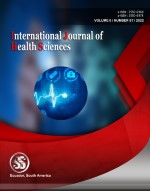Decoding the changing etiology and management protocols of intestinal obstruction: A prospective clinical study
Keywords:
Bowel Obstruction, Mortality, Morbidity, Intestinal Obstruction, TachycardiaAbstract
Background: Obstruction of the bowel is one of the most common problems intra-abdominally seen by surgeons in their practice. The reasons associated with these obstructions are biochemical disturbances correlated to adhesion, neoplasms, and/or hernia. Obstruction of either the large intestine or small intestine remains the major cause of mortality and morbidity. Methods: The study included a total of 48 subjects having intestinal obstruction within the age range of 18-87 years. The diagnosis was made based on hematologic parameters, radiologic parameters, physical examination, and clinical history of the subjects. Results: Most common complication seen in 14.58% (n=7) study subjects, followed by the surgical site infection seen in 10.41% (n=5) study subjects. Respiratory tract infection was seen in 8.33% (n=4) of study subjects. The least common reported complication was faecal fistula seen in 4.16% (n=2) of study subjects. On assessing the mortality rate of the present study, it was seen that 12.5% (n=6) subjects died following surgical management of acute abdominal distension, whereas, 87.5% (n=42) subjects survived and were cured Conclusion: The present study concludes that the most common reason behind intestinal obstruction was postoperative adhesion which can be accurately diagnosed with operative, radiological, and clinical assessment.
Downloads
References
Gore RM, Silvers RI, Thakrar KH, et al. Bowel obstruction. Radiol Clin N Am. 2015;53:1225–40.
Batke M, Cappell MS. Adynamic ileus and acute colonic pseudo-obstruction. Med Clin North Am. 2008;92:649–70.
Frago R, Ramirez E, Millan M, Kreisler E, del Valle E, Biondo S. Current management of acute malignant large bowel obstruction: a systematic review. Am J Surg. 2014;207:127–38.
Taylor MR, Lalani N. Adult small bowel obstruction. Acad Emerg Med. 2013;20:528–44.
Haridimos Markogiannakis, Evangelos Messaris, Dimitrios Dardamanis, Nikolaos Pararas, Dimitries Tzerzemelis, Panagiotis Giannopoulos et al. Acute mechanical obstruction: Clinical presentation, aetiology, management and outcome. World J Gastroenterol. 2007;13:432-7.
Richard LD Rake, Wayne Vogl A, Adam WM Mitchell. Abdomen. 2nd ed.Chapter 4.In: Gray’s Anatomy for students. Philadelphia: Churchill Livingstone Elsevier, 2010, 300p.
Robert MB Erne. Gastrointestinal regulation and motility.5th ed.Chapter 31.In:Physiology, Robert MB erne, Mathew N Levy, Bruce MK oeppen, Bruce AS tanton, eds. Mos by Publication, 2008, 539p.
Branco BC, Barmparas G, Schnuriger B, Inaba K, Chan LS, Demetriades D. Systematic review and meta-analysis of the diagnostic and therapeutic role of water-soluble contrast agent in adhesive small bowel obstruction. Br J Surg. 2010;97:470–8.
Ten Broek RP, Issa Y, van Santbrink EJ, et al. Burden of adhesions in abdominal and pelvic surgery: systematic review and met-analysis. BMJ. 2013;347:5588.
Jaffe T, Thompson WM. Large-bowel obstruction in the adult: classic radiographic and CT findings, etiology, and mimics. Radiology. 2015;275:651–63.
Suryasa, I. W., Rodríguez-Gámez, M., & Koldoris, T. (2021). Get vaccinated when it is your turn and follow the local guidelines. International Journal of Health Sciences, 5(3), x-xv. https://doi.org/10.53730/ijhs.v5n3.2938
Published
How to Cite
Issue
Section
Copyright (c) 2022 International journal of health sciences

This work is licensed under a Creative Commons Attribution-NonCommercial-NoDerivatives 4.0 International License.
Articles published in the International Journal of Health Sciences (IJHS) are available under Creative Commons Attribution Non-Commercial No Derivatives Licence (CC BY-NC-ND 4.0). Authors retain copyright in their work and grant IJHS right of first publication under CC BY-NC-ND 4.0. Users have the right to read, download, copy, distribute, print, search, or link to the full texts of articles in this journal, and to use them for any other lawful purpose.
Articles published in IJHS can be copied, communicated and shared in their published form for non-commercial purposes provided full attribution is given to the author and the journal. Authors are able to enter into separate, additional contractual arrangements for the non-exclusive distribution of the journal's published version of the work (e.g., post it to an institutional repository or publish it in a book), with an acknowledgment of its initial publication in this journal.
This copyright notice applies to articles published in IJHS volumes 4 onwards. Please read about the copyright notices for previous volumes under Journal History.
















